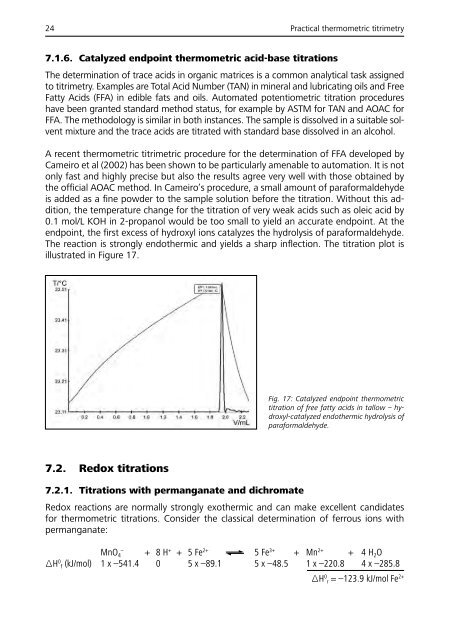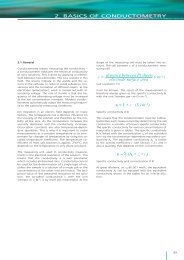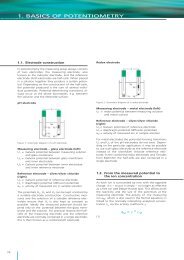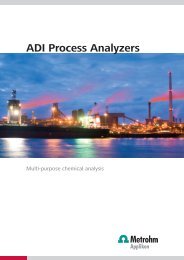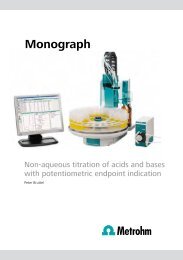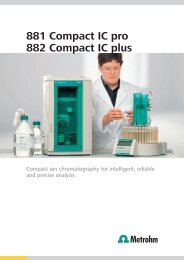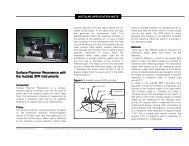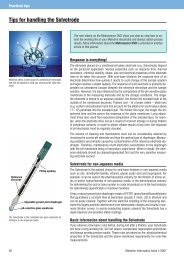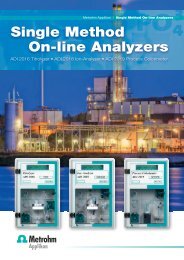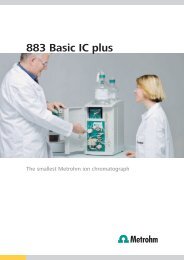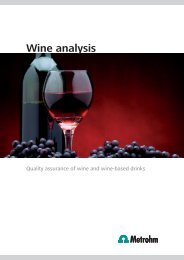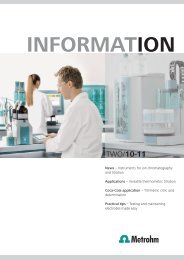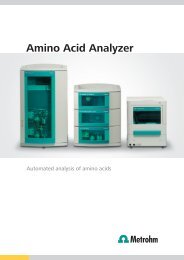Monograph - Metrohm
Monograph - Metrohm
Monograph - Metrohm
Create successful ePaper yourself
Turn your PDF publications into a flip-book with our unique Google optimized e-Paper software.
24 Practical thermometric titrimetry<br />
7.1.6. Catalyzed endpoint thermometric acid-base titrations<br />
The determination of trace acids in organic matrices is a common analytical task assigned<br />
to titrimetry. Examples are Total Acid Number (TAN) in mineral and lubricating oils and Free<br />
Fatty Acids (FFA) in edible fats and oils. Automated potentiometric titration procedures<br />
have been granted standard method status, for example by ASTM for TAN and AOAC for<br />
FFA. The methodology is similar in both instances. The sample is dissolved in a suitable solvent<br />
mixture and the trace acids are titrated with standard base dissolved in an alcohol.<br />
A recent thermometric titrimetric procedure for the determination of FFA developed by<br />
Cameiro et al (2002) has been shown to be particularly amenable to automation. It is not<br />
only fast and highly precise but also the results agree very well with those obtained by<br />
the official AOAC method. In Cameiro’s procedure, a small amount of paraformaldehyde<br />
is added as a fine powder to the sample solution before the titration. Without this addition,<br />
the temperature change for the titration of very weak acids such as oleic acid by<br />
0.1 mol/L KOH in 2-propanol would be too small to yield an accurate endpoint. At the<br />
endpoint, the first excess of hydroxyl ions catalyzes the hydrolysis of paraformaldehyde.<br />
The reaction is strongly endothermic and yields a sharp inflection. The titration plot is<br />
illustrated in Figure 17.<br />
Fig. 17: Catalyzed endpoint thermometric<br />
titration of free fatty acids in tallow – hydroxyl-catalyzed<br />
endothermic hydrolysis of<br />
paraformaldehyde.<br />
7.2. Redox titrations<br />
7.2.1. Titrations with permanganate and dichromate<br />
Redox reactions are normally strongly exothermic and can make excellent candidates<br />
for thermometric titrations. Consider the classical determination of ferrous ions with<br />
permanganate:<br />
–<br />
MnO 4 + 8 H + + 5 Fe 2+ 5 Fe 3+ + Mn 2+ + 4 H 2 O<br />
ΔH 0 f (kJ/mol) 1 x –541.4 0 5 x –89.1 5 x –48.5 1 x –220.8 4 x –285.8<br />
ΔH 0 r = –123.9 kJ/mol Fe 2+


